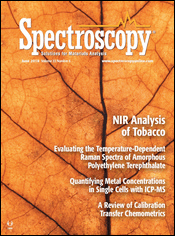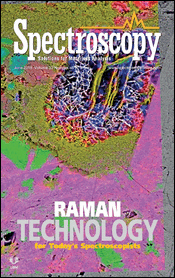In our June issue:
COLUMNS
Molecular Spectroscopy Workbench
2D COS of Temperature-Dependent Raman Spectra of Amorphous, Nonoriented Polyethylene Terephthalate to Separate Molecular Conformational Changes from True Crystallization
Fran Adar
Because of the structural use of polymers, it is important to understand the origin of their strength, elongation to break, elasticity, flexibility, and so on. It is in the very low frequency region (the so called "terahertz" range) where it is believed that the real indicators for crystallinity appear.
Read more »
|
ADVERTISEMENT
Improving the Elemental Analysis of Polymers and Plastics Using XRF
Thursday, June 21, 2018 at 11am EDT | 8am PDT | 4pm BST | 5pm CEST
 Register now Register now |
Chemometrics in Spectroscopy
Calibration Transfer Chemometrics, Part II: A Review of the Subject
Jerome Workman Jr. and Howard Mark
Carboxylates are made by reacting carboxylic acids with strong bases such as inorganic hydroxides. Carboxylates contain two unique carbon–oxygen "bond and half" linkages that coordinate with a metal ion to give two strong infrared peaks, which make them easy to see.
Read more »
|
ADVERTISEMENT
Exploring Four Capabilities that are Defining the Future of ICP-MS
On Demand
 Learn more Learn more |
Peer-Reviewed Articles
Exploring the Applicability of Quantitative Models Based on NIR Reflectance Spectroscopy of Plant Samples
Yuqing Yang, Li Ma, Guorong Du, Junhui Li, and Yanjun Ma
The establishment of quantitative models based on the near-infrared (NIR) spectroscopic analysis of plant samples plays an important role in improving both the scope of the models and the accuracy of prediction. This technique could provide a new method for tobacco quality management and provide a new discriminant method for other agricultural products.
Read more »
|
ADVERTISEMENT
Any Sample, Any Time: The Benefits of Single Reaction Chamber Microwave Digestion for Trace Element Analysis
On Demand
 Learn more Learn more |
Single-Cell ICP-MS Analysis: Quantifying the Metal Concentration of Unicellular Organisms at the Cellular Level
Ruth Merrifield, Lauren Amable, and Chady Stephan
Single-cell ICP-MS can accurately quantify the metal concentrations within individual cells, providing new information about the mean metal content and the variation within a cell population. This method is shown to be a vital tool for assessing the specific uptake of metals by ovarian cancer cells and fresh water algae.
Read more » |
|
 |
Download the
issues: |
 |
 |
 |
 |
 |
 |
| |
| ON DEMAND WEBCASTS |
A-TEEM™ Molecular Fingerprinting: A New and Exciting Spectroscopy Technique
Sign Up Here » |
Improving Extractables and Leachables and Trace Metal Testing of Pharmaceutical Packaging
Sign Up Here » |
Understanding the Advantages of Microwave Extraction Technology for Environmental Laboratories
Sign Up Here » |
|
If you would like to submit an article to Spectroscopy, contact Laura Bush, Editorial Director - Laura.Bush@ubm.com
Spectroscopy is free to qualified subscribers. To subscribe, click here.
Click here to contact the Spectroscopy sales team. |


